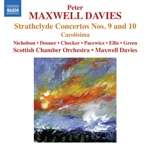|
Back
03/04/2014
Peter Maxwell Davies: Strathclyde Concertos No. 9, Op. 170, & No. 10, Op. 179 – Carolísima, Op. 168
David Nicolson (piccolo), Elisabeth Dooner (alto flute), Maurice Checker (cor anglais), Josef Pacewicz (E-flat clarinet), Ruth Ellis (bass clarinet), Alison Green (contrabassoon), Scottish Chamber Orchestra, Peter Maxwell Davies (conductor)
Recorded at City Hall, Glasgow (November 23 & 24, 1996) – 77’01
Naxos 8.572356 – Notes in English

   
As Richard Taruskin recounts in his Music of the Late Twentieth Century (the fifth and final volume of his Oxford History of Western Music), Sir Peter Maxwell Davies allied himself with the avant garde of the sixties, but then turned his back on the movement, becoming a British regionalist figure, living in the Orkney Islands and composing works in an accessible style. While Taruskin hears influence from Sibelius, the works on this disc seem to be more post-Debussy than anything else.
The first item is Strathclyde Concerto No. 9, composed in 1994, for six woodwind players and strings. The name of the piece refers to the Strathclyde regional government (greater Glasgow, Scotland) who commissioned a varied series of works as part of an educational program. Each concerto features a different instrument or group, thus the unusual group of winds in this piece. The work is in one movement with linked moderato-allegro-lentissimo sections. The plaintive opening features high- and low-lying juxtapositions, such as piccolo and contrabassoon, the latter coming across as a melodic foghorn. The composer was inspired “by the infinite variety of shading within the winter greys of (his) Orkney home”. The piece certainly evokes bleakness, and dwindles to a plaintive ending.
The Strathclyde Concerto No. 10, composed in 1996, wrapped up the series. It is termed a “concerto for orchestra”, as it has sections that play off various parts of the orchestra against the rest. If anything, it is even more evocative of moody Scottish light and atmosphere than No. 9. The opening Allegro non troppo is much more non troppo than allegro; it evokes loneliness with subdued colours that briefly glint and shimmer. The Lento movement is lingering and minimal, with washes of sound; it achieves tension toward the end. The finale, a Moderato, evokes sunlight on waves; after some leaps and bounds it dies away.
The third work on the disc, Carolísima (from 1994) has a lot of charm, as does the story behind its creation. It was commissioned as a birthday gift by a man for his wife, Carol (thus the title); her birthday was in a hotel venue large enough to contain the smuggled-in orchestra. The man wanted the piece to contain at least two hummable tunes (there are three) as well as something to dance to. It sounds very Scottish with use of the “Scotch snap” and a pentatonic stretch; Maxwell Davies also included references to a favourite composer of the dedicatee, Aaron Copland. It has both jaunty and moody moments, and ends on a pensive note.
If someone had commissioned this for my birthday I would have been very happy, but would not have minded a livelier finish.
One problem with repertory like this is that is for chamber orchestra - i.e., not a full symphony and not small chamber ensemble like a quartet, etc. Big orchestras do downsize on occasion for certain repertory, mainly from the classical era. And while there are many small orchestras dedicated to the 18th century and earlier, more recent works don’t have the multiplicity of ready showcases that both larger- and smaller- scale works have. A recording such as this - which one can assume to be definitive as it is conducted by the composer with the musicians for whom the works were specifically composed - can help inspire the live performances they deserve.
This recording was released on Collins Classics in 1996. Each work has much of interest but there is not much contrast between them. Thus it is a recording to savour piece-by-piece, not as an program or entity in itself.
Michael Johnson
|